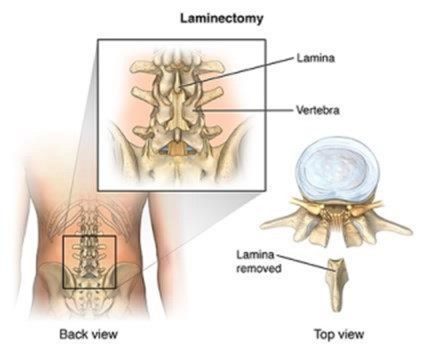A nurse is caring for a client who is postoperative following a laminectomy with spinal fusion. Which of the following actions should the nurse take?
Position the client in a high-Fowler's position if clear drainage is noted on the dressing
Monitor sensory perception of the lower extremities.
Assist the client into a knee-chest position to manage postoperative discomfort.
Maintain strict bed rest for the first 48 hr postoperative.
The Correct Answer is B
A. Positioning the client in a high-Fowler's position if clear drainage is noted on the dressing is not a specific intervention for a laminectomy with spinal fusion. The nurse should follow the surgeon's specific postoperative orders regarding positioning and wound care.
B. Monitoring sensory perception of the lower extremities is a crucial nursing intervention after a laminectomy with spinal fusion. This is to assess for any signs of neurovascular compromise or nerve damage.
C. Assisting the client into the knee-chest position to manage postoperative discomfort is not a recommended position after a laminectomy with spinal fusion. The nurse should follow the surgeon's specific postoperative orders regarding positioning.
D. Maintaining strict bed rest for the first 48 hours postoperative is not typically indicated after a laminectomy with spinal fusion. Early mobilization and ambulation are often encouraged to prevent complications and promote recovery. The nurse should follow the surgeon's specific postoperative orders regarding activity and mobility.

Nursing Test Bank
Naxlex Comprehensive Predictor Exams
Related Questions
Correct Answer is D
Explanation
A. Protective isolation is not routinely required for clients following scoliosis repair unless there is an underlying infection risk.
B. A PCA pump may be used for pain control, but it is not specific to post-scoliosis repair care.
C. Keeping the head of the bed at 30° is not required; positioning should focus on spinal alignment.
D. Log rolling the client every 4 hours is essential to maintain spinal alignment, prevent complications, and ensure safety following Harrington rod instrumentation.
Correct Answer is ["63"]
Explanation
- To calculate the gtt/min, use the formula: gtt/min = (volume in mL x drop factor in gtt/mL) / time in min
- Substitute the given values: gtt/min = (250 mL x 15 gtt/mL) / 60 min - Simplify and round: gtt/min = 62.5 gtt/min ≈ 63 gtt/min
- The nurse should set the manual IV infusion to deliver 63 gtt/min
Whether you are a student looking to ace your exams or a practicing nurse seeking to enhance your expertise , our nursing education contents will empower you with the confidence and competence to make a difference in the lives of patients and become a respected leader in the healthcare field.
Visit Naxlex, invest in your future and unlock endless possibilities with our unparalleled nursing education contents today
Report Wrong Answer on the Current Question
Do you disagree with the answer? If yes, what is your expected answer? Explain.
Kindly be descriptive with the issue you are facing.
